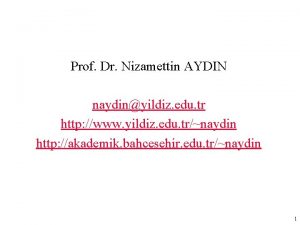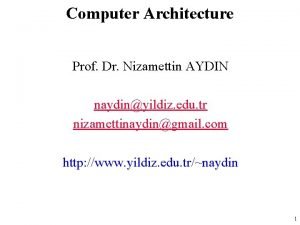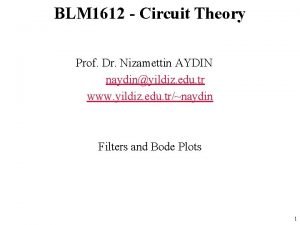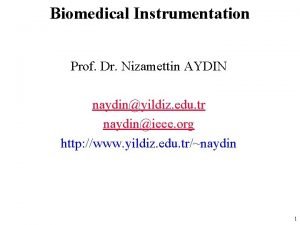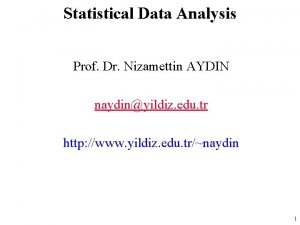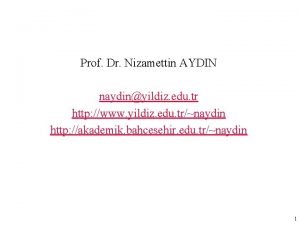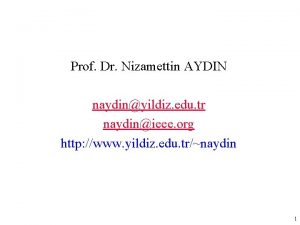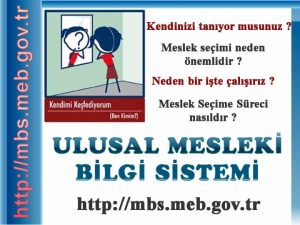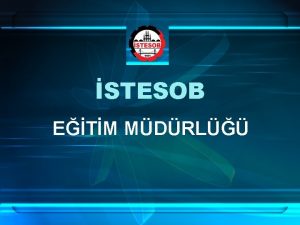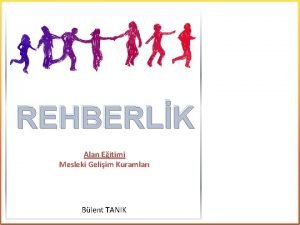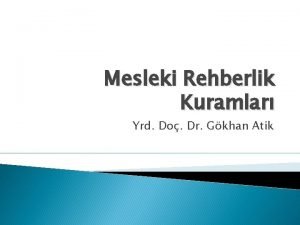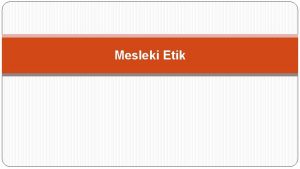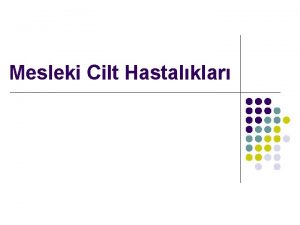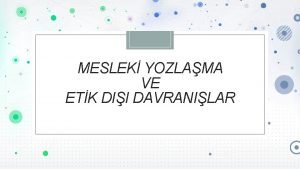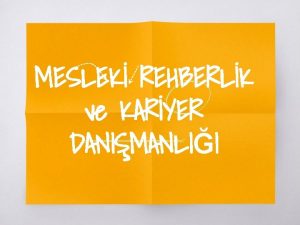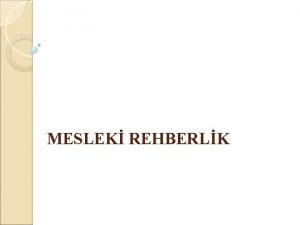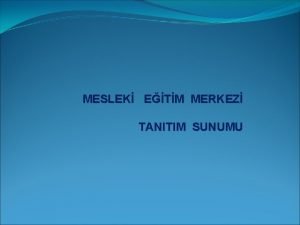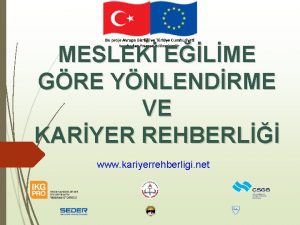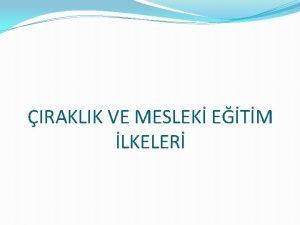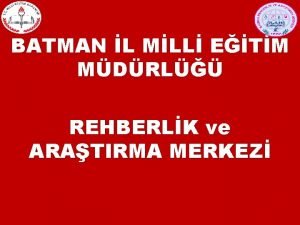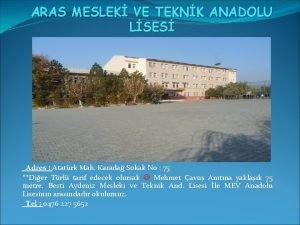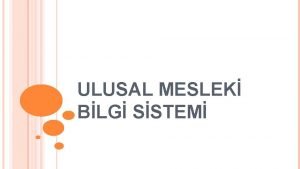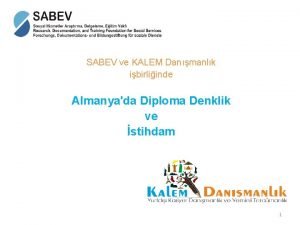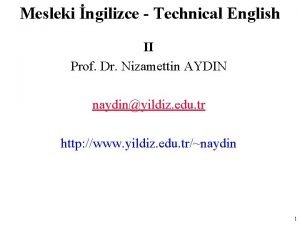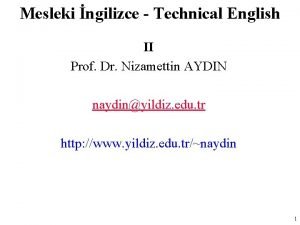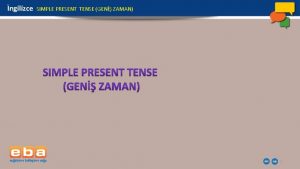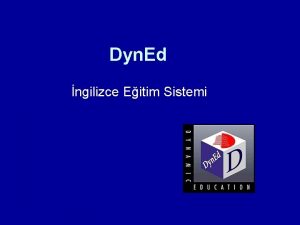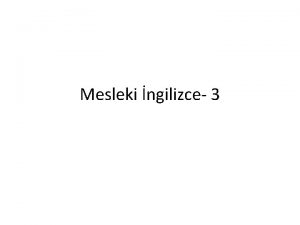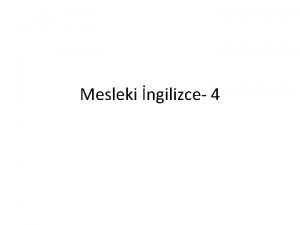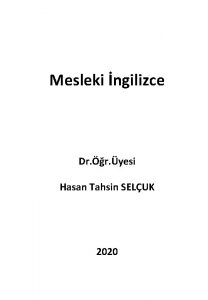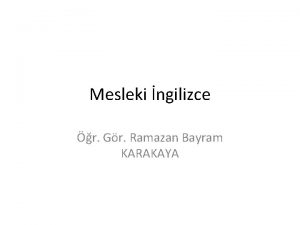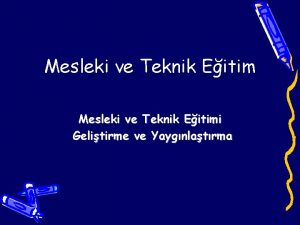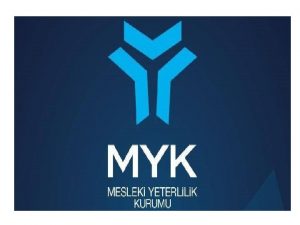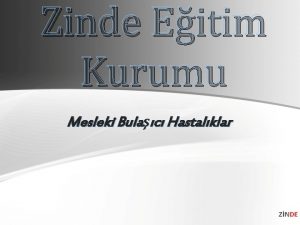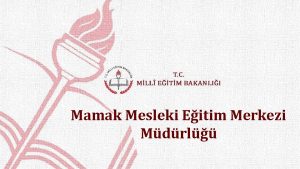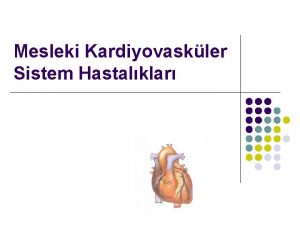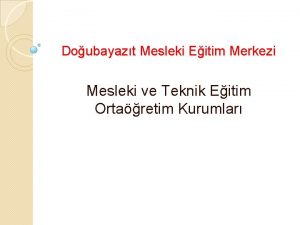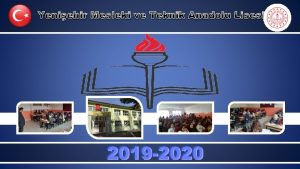Mesleki ngilizce Technical English II Prof Dr Nizamettin




























- Slides: 28

Mesleki İngilizce - Technical English II Prof. Dr. Nizamettin AYDIN naydin@yildiz. edu. tr http: //www. yildiz. edu. tr/~naydin 1

• Notes: – In the slides, • texts enclosed by curly parenthesis, {…}, are examples. • texts enclosed by square parenthesis, […], are explanations related to examples. 2

HISTORY OF COMPUTERS • Learning objectives – to acquire basic knowledge about computer history • Sub-areas covered – Computer history 3

HISTORY OF COMPUTERS • Keywords – punched card • a card on which data can be recorded in the form of punched holes – binary code • code using a string of 8 binary digits to represent characters – ENIAC • Electronic Numerical Integrator and Computer – EDVAC • Electronic Discrete Variable Computer 4

Punch Card 5

Digital Data 6

HISTORY OF COMPUTERS • Reading text • Pre-reading questions – Why do so many people not know how the modern computer began? – Why do you think the computer has changed more rapidly than anything else? – How do you think WW 2 might have been different if the ENIAC, the first all electrical computer, whose first job was to calculate the feasibility of a design for the hydrogen bomb, had not been invented then? 7

HISTORY OF COMPUTERS • Comprehension questions – Why was Pascal honored with a computer language named for him? • This programming language was named as a tribute to Blaise Pascal, because of his contribution to computer development. He was the first to build a precursor of the modern computer-an adding an subtraction machine that could assist in tedious and time-consuming computational process. 8

HISTORY OF COMPUTERS • Comprehension questions – Who was the first to invent a machine whose operating principle is very similar to present-day computers? Describe these similarities. • Charles Babbage, whose idea was remarkably similar to the way modern computers work: read program from punched cards (input), figure and store the answers to different problems, and print the answer on paper (output) 9

HISTORY OF COMPUTERS • Comprehension questions – In which process was Hollerith’s machine involved and what was its role? • Hollerith’s machine helped with the counting of census information. It took three years, instead of seven and half, even with 13 million more people since the previous census. “The machine read and sorted data from punched cards. The holes punched in the cards matched each person’s answers to questions. For example, married, single, and divorced were answers on the cards. The Tabulator read the punched cards as they passed over tiny brushes. Each time a brush found a hole, it completed an electrical circuit. This caused special counting dials to increase the data for that answer. 10

HISTORY OF COMPUTERS • Comprehension questions – Describe all the technical parameters of the first electric powered computer. • 50 feet long, 8 feet tall, electrical circuits are opened and closed by mechanical switches, contained 500 miles of wire and 750 000 parts – What were the differences between the Mark I and the ENIAC? • Mark I - electric powered, 50 feet long and 8 tall, used mechanical switches to open/close electrical circuits • ENIAC - all electronic computer, used 18, 000 vacuum tubes instead of mechanical switches, 1000 times faster than Mark I, 100 feet long and 10 feet tall 11

HISTORY OF COMPUTERS • Comprehension questions – What is the main advantage of using binary code in storing data and instructions? • First computers like the ENIAC could do only one task, then they had to be rewired to perform a different task or program. The binary code concept of storing different programs on punched cards instead of rewiring computers led to computers that we know today. • Possible topics for discussion – Future of computers. 12

Historical Development • To fully appreciate the computers of today, it is helpful to understand how things got the way they are. • The evolution of computing machinery has taken place over several centuries. • In modern times computer evolution is usually classified into four generations according to the salient technology of the era. We note that many of the following dates are approximate.

Historical Development • Generation Zero: Mechanical Calculating Machines (1642 1945) – Calculating Clock - Wilhelm Schickard (1592 - 1635). – Pascaline - Blaise Pascal (1623 - 1662). – Difference Engine - Charles Babbage (1791 - 1871), also designed but never built the Analytical Engine. – Punched card tabulating machines - Herman Hollerith (1860 1929). Hollerith cards were commonly used for computer input well into the 1970 s.

Mechanical Brains – Abacus – Slide Rule – Difference Engine – Mechanical Calculators http: //web. mit. edu/mindell/www/analyzer. htm – Differential Analyzer

Historical Development • The First Generation: Vacuum Tube Computers (1945 1953) – Atanasoff Berry Computer (1937 - 1938) solved systems of linear equations. – John Atanasoff and Clifford Berry of Iowa State University.

Historical Development • The First Generation: Vacuum Tube Computers (1945 1953) – Electronic Numerical Integrator and Computer (ENIAC) – John Mauchly and J. Presper Eckert – University of Pennsylvania, 1946 The first general-purpose computer.

Historical Development • The First Generation: Vacuum Tube Computers (1945 1953) – IBM 650 (1955) – Phased out in 1969. The first mass-produced computer.

Historical Development • The Second Generation: Transistorized Computers (1954 - 1965) – IBM 7094 (scientific) and 1401 (business) – Digital Equipment Corporation (DEC) PDP-1 – Univac 1100 –. . . and many others. DEC PDP-1

Historical Development • The Third Generation: Integrated Circuit Computers (1965 - 1980) – IBM 360 – DEC PDP-8 and PDP-11 – Cray-1 supercomputer –. . . and many others. IBM 360 Cray-1

Historical Development • The Fourth Generation: VLSI Computers (1980 - ? ? ) – Very large scale integrated circuits (VLSI) have more than 10, 000 components per chip. – Enabled the creation of microprocessors. – The first was the 4 -bit Intel 4004. Later versions, such as the 8080, 8086, and 8088 spawned the idea of “personal computing. ” Intel 4004

Historical Development • Moore’s Law (1965) – Gordon Moore, Intel founder – “The density of transistors in an integrated circuit will double every year. ” • Contemporary version: – “The density of silicon chips doubles every 18 months. ” But this “law” cannot hold forever. . .

Historical Development • Rock’s Law – Arthur Rock, Intel financier – “The cost of capital equipment to build semiconductors will double every four years. ” – In 1968, a new chip plant cost about $12, 000. At the time, $12, 000 would buy a nice home in the suburbs. An executive earning $12, 000 per year was “making a very comfortable living. ”

Historical Development • Rock’s Law – In 2003, a chip plants under construction will cost over $2. 5 billion is more than the gross domestic product of some small countries, including Belize, Bhutan, and the Republic of Sierra Leone. – For Moore’s Law to hold, Rock’s Law must fall, or vice versa. But no one can say which will give out first.

Computer Usage • You are going to hear four people talk about how they use computers. • Before you listen, try to predict the uses they describe. 25

Computer Usage • Listening 26

Computer Usage • Grammar revision – Past simple – Present perfect • We use the Present perfect to describe past actions with present relevance. – The artist uses the Present perfect because he is describing a CD he has just made and what he is going to do with it in the near future. • {I've scanned in about a third of these photographs. } • {I've organised the paintings into themes. } • {I've added a sound track. } 27

Computer Usage • We use the Past simple to describe completed actions in the past. – It is often used with time expressions such as last year, before PCs were introduced, in 1998. – Note these examples from the recording: • {I made one for Mary's birthday last week. } • {We tried it out last term. } 28
 Prof. dr. nizamettin aydin
Prof. dr. nizamettin aydin Nizamettin aydin
Nizamettin aydin Prof. dr. nizamettin aydin
Prof. dr. nizamettin aydin Prof. dr. nizamettin aydin
Prof. dr. nizamettin aydin Ngilizce
Ngilizce Nizamettin aydin
Nizamettin aydin Nizamettin aydin
Nizamettin aydin Kilo mega giga tera peta
Kilo mega giga tera peta Asd ste
Asd ste Forms of technical communication
Forms of technical communication Ulusal mesleki bilgi sistemi
Ulusal mesleki bilgi sistemi Realschule türkiye'de hangi okula denk
Realschule türkiye'de hangi okula denk Meslek seçimi kuramları
Meslek seçimi kuramları Rehberlik kuramları
Rehberlik kuramları Deontolojik etik
Deontolojik etik çimento yanığı
çimento yanığı Mesleki yozlaşma nedir
Mesleki yozlaşma nedir Kariyer soy ağacı
Kariyer soy ağacı Isaacson mesleki gelişim kuramı
Isaacson mesleki gelişim kuramı Mesleki eğitim merkezi tanıtım
Mesleki eğitim merkezi tanıtım Maybe meslek testi
Maybe meslek testi Osman düşüngel mesleki eğitim merkezi
Osman düşüngel mesleki eğitim merkezi Hezarfen mesleki ve teknik anadolu lisesi
Hezarfen mesleki ve teknik anadolu lisesi Batman piri reis mesleki ve teknik anadolu lisesi
Batman piri reis mesleki ve teknik anadolu lisesi Aras mesleki ve teknik anadolu lisesi
Aras mesleki ve teknik anadolu lisesi Mesleki bilgi sistemi
Mesleki bilgi sistemi Almanyada diploma denkliği
Almanyada diploma denkliği Necatibey mesleki ve teknik anadolu lisesi
Necatibey mesleki ve teknik anadolu lisesi Super yaşam boyu yaşam alanı
Super yaşam boyu yaşam alanı
